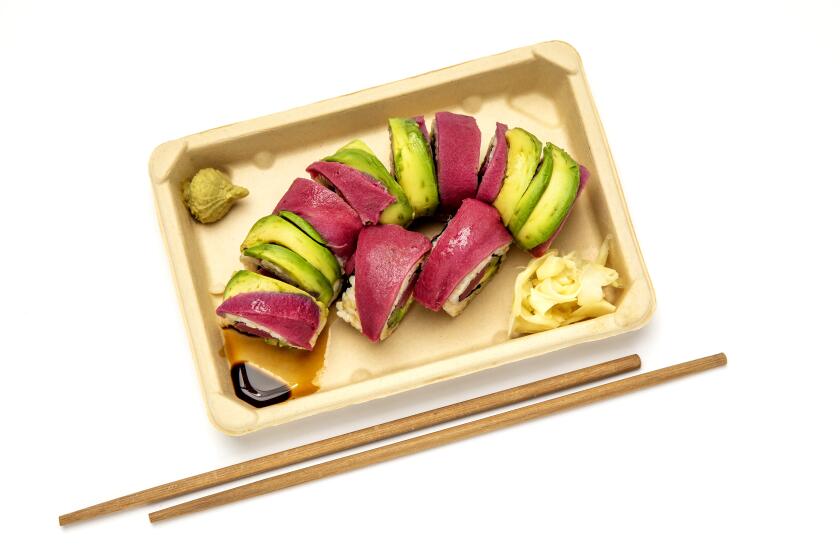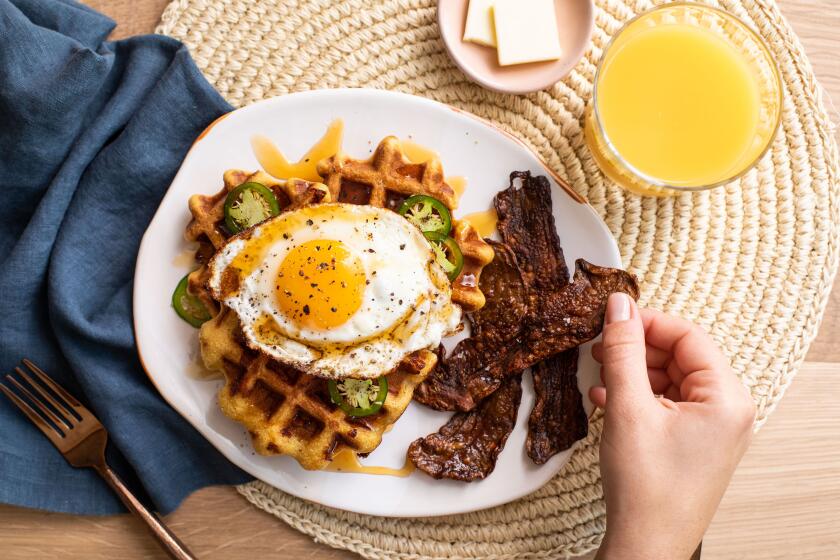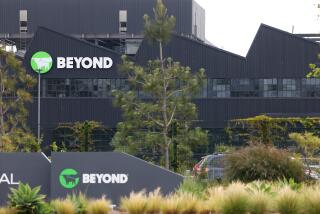Prepare yourself for an avalanche of fake meat

- Share via
This story is part of our series on the future of cultured and plant-based meat. Read more here.
It was an ordinary looking bit of what appeared to be raw chicken. When seared in grape seed oil, its edges crisped light brown. The meat tore easily, revealing the stringy structure of a chicken tender. Seasoned with salt and pepper, it was moist, chewy and tasted like chicken.
And it is 100% chicken, according to its producer, Berkeley-based Upside Foods. This meat — cultured meat — was cultivated in vitro from cells harvested from a chicken embryo. Upside is currently allowing consumer groups and journalists to sample its product as part of a full-court effort to demystify a product that has never been sold in the United States.
That may soon change.
Within six months, cultured meat companies say they expect the Food and Drug Administration and the U.S. Department of Agriculture, both of which have a say, to set the rules for getting their products to market. That, in turn, is expected to pave the way for cultured meat to start popping up in select restaurants next year. (It likely will be years before companies are able to produce enough cultured meat — competitively priced — for grocery store sales.)
Beyond Meat and Impossible Foods already proved meat lovers will put alternative proteins at the center of their plates … at least sometimes. You can find their plant-based products — including sausages and burger patties — in Ralphs, Vons and Whole Foods or grab their burgers at Burger King, McDonald’s and Umami Burger. According to the alt-protein advocates at the Good Food Institute and Plant Based Foods Assn., their success propelled sales of U.S. plant-based alt-protein products in 2020 to $1.4 billion, a 45% increase over 2019, and that success has inspired a tsunami of alt-protein products.
The fast-expanding array of meat mimics — plant-based, cultured and fungi-based — are quickly evolving as producers push to match the nutrition, taste, look, feel, smell and cost of conventional meat. In no time, consumers will have “alternatives that will be flat-out identical products to those from animals,” says Eric Toone, technical advisor to Bill Gates’ Breakthrough Energy Ventures, a fund investing in carbon reduction technologies, including alt-proteins.

Toone is a true believer — a proselytizer — but there are reasons to believe his prediction will come true. Eventually.
Livestock contributes 14.5% of the world’s human-induced greenhouse gas emissions, according to a report from the Food and Agriculture Organization of the United Nations that suggests drastic reductions in meat consumption to slow climate change. In addition, livestock use about 15% of Earth’s land for grazing (mainly grasslands and range lands) and around 40% of cropland to grow their feed.
Alt-proteins are an entrepreneurial approach to curbing those emissions. Led, for the most part, by a group of dedicated vegans, including the founders of Beyond and Impossible, they believe that mimicking conventional meat is the easiest way to convince carnivores to change their diets and the fastest way to end industrial animal agriculture. Still, the data to back up that belief are limited.
We tried more than 25 alt-protein burger, sausage, chicken nugget and fish products. Here’s a breakdown of the best and worst
A comparison study by Dutch sustainability consultants CE Delft says that by 2030, when large-scale commercial production of lab-grown meat is expected to be possible, pound for pound, lab-grown meat could have the potential to contribute 92% fewer global warming gases and use 95% less land and 78% less water than conventional beef.

Amazing, right? Maybe, says Phil Howard, a Michigan State University associate professor of community sustainability and a member of the International Panel of Experts on Sustainable Food Systems. He believes no one has done a credible comparison of the environmental impact of today’s alt-proteins with the meats they are to replace, a common lament among food experts.
This story is part of our series on the future of cultured and plant-based meat. Read more here.
For now, the environmental advantage of plant-based foods is best demonstrated by weight, according to Michael Clark, a research scientist with Oxford University’s Future of Food Program. It takes 40 kilograms of plants to produce one kilogram of beef, while a kilogram of plants on your plate nets a kilogram of food.
Toone, citing data from the Food and Agriculture Organization of the United Nations, says global greenhouse gas emissions for cows and cars are roughly equivalent. Once consumers understand that, he adds, they will choose alt-proteins.
So, how exactly will they be won over?
“The simplest way to educate consumers is through labeling,” Toone says, showing the grams of CO2 emissions per gram of food on the nutrient label. (Labels are a hot topic among the alt-protein faithful.)
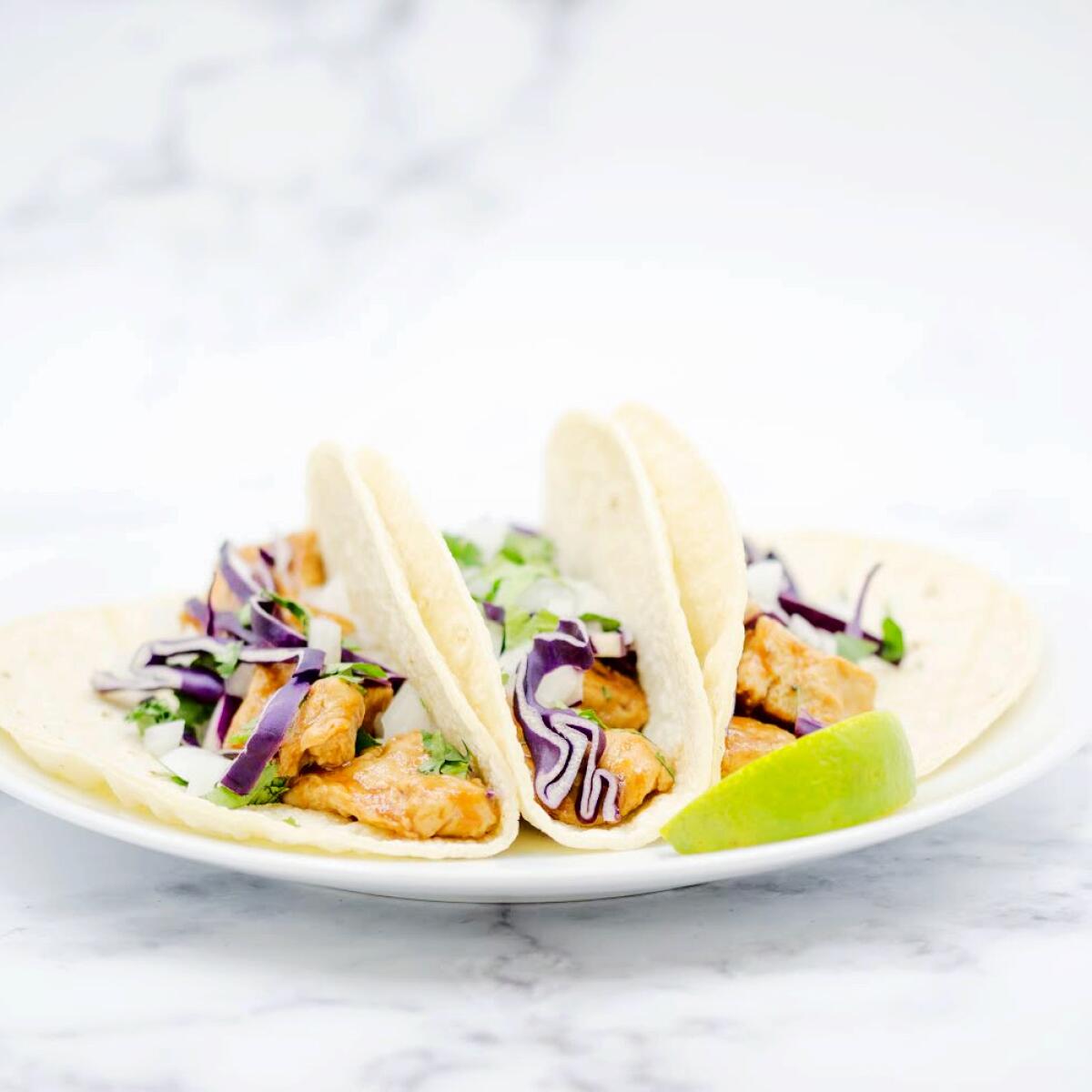
Without such labels, “It is a fantasy that reducing meat consumption will be a consumer-driven movement,” says Clark, who is developing an emissions database for food that would pave the way for such labels.
Will governments ask, much less demand, that meat producers disclose how damaging their product is to the environment? They have to, Clark says.
If only it were that easy.
::
Cargill, the third largest player in the $1-trillion global meat industry, built its new North American Protein Headquarters in Wichita, Kan., where its mammoth beef operation shares the building with its fledgling alt-protein business. Elizabeth Gutschenritter, Cargill’s managing director of alternative proteins, says “protein is one business” at her company.
Companies are flocking to alt-protein central — California
Working down the hall from Cargill’s buzzy cattle-trading room filled with salespeople on headsets, Gutschenritter’s nine-person team has built the company into the largest private-label producer of alt-proteins — for customers such as grocery stores and big-box outlets — in North America.
There now are plant-based products that mimic an expanding variety of fish, as well as chicken and pork.
“If there’s a conventional animal-based protein, we intend for there to be a Cargill plant-based option,” she says, adding, “That will be even easier to do with cell-cultured meats.”
Other giants in the meat industry are similarly enthusiastic about alt-proteins. Speaking from his office in São Paulo, Brazil, Gilberto Tomazoni, chief executive of JBS, the world’s largest meat processor, says his company plans to produce every type of alt-protein, including cultured meat. Asked if he thinks of himself as one of the “bad guys” responsible for today’s environmentally damaging industrial meat system, a universal sentiment among the leaders of the alt-protein movement, Tomazoni laughs. “No, no. We are all friends. We are not in competition,” he says, sidestepping the issue.
Worldwide demand for protein is growing rapidly, with meat sales at an all-time high, Tomazoni says, citing a United Nations forecast that predicts global demand for all proteins will increase 70% by 2050 as economies improve across Asia and Africa.
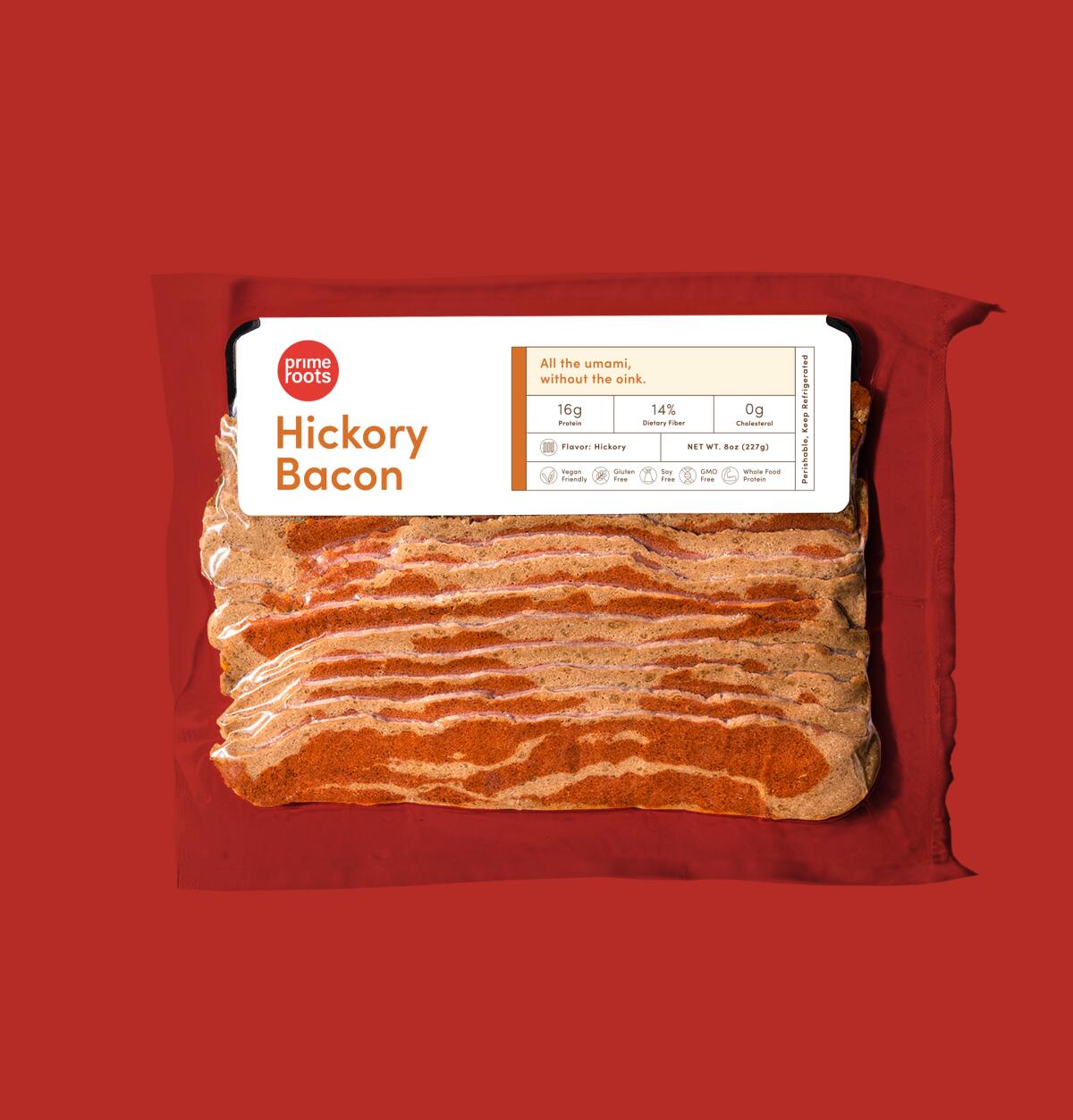
Research by Kearney management consultants makes Big Meat’s embrace of alt-proteins easy to understand.
In 20 years, according to the 2021 study, the worldwide market for all types of meats. alternative and otherwise, will be $1.8 trillion. Annual plant-based alt-protein sales by then could reach $450 billion. Cultured meats, such as Upside’s chicken, will likely be even more popular, according to Kearney, with annual sales reaching $630 billion.
In the future, is it possible that Big Meat will dominate all protein categories? “They can do things on scale,” says Dale Jamieson, director of the Center for Environmental and Animal Protection at New York University, where he is a professor of environmental studies, philosophy and bioethics. “They can get legislation passed in Congress.”
::
The knock on alt-proteins continues to be that they are highly processed foods, and consumers have been told that is bad for them, but that’s not necessarily true.
“Americans don’t have a nutrition problem,” says Marion Nestle, a New York University professor emeritus of nutrition, food studies and public health. “They eat too many calories.” And Nestle doubts alt-proteins increase calorie consumption — they’re designed for health-conscious consumers with money.
“I have friends who like Beyond and Impossible. I respect that,” she says. But she’s an Alice Waters fan. The flavor of real meat is born in the pasture. The connection to soil matters — and that means Nestle is not buying alt-proteins. “I have a food rule: Never eat anything artificial,” she says. “These foods are off my radar.”
But most Americans can’t afford to eat farm-to-table; they eat meat from factory-farm animals. It appears plant-based and cultured meat, at least, avoid the antibiotics and food-borne illnesses endemic to cheaper meat.
Where to find plant-based meat products at fast-casual restaurants in Los Angeles and Orange County.
Christopher Gardner, a Stanford University nutrition scientist and vegan evangelist, says a dinner of lentil salad and three-bean soup beats any alt-protein. But for someone who would otherwise order a fast-food burger at the drive-through, an alt-protein is a vast improvement. The health value, he says, depends on what the alt-protein replaces.
In 2013, Mark Post, a tissue scientist at a Dutch university, produced the first cultured-meat hamburger — a $325,000 patty paid for by Google founder Sergey Brin. Post predicted that cultured meats would be on dinner tables by 2018.
Even though his prediction did not come true, Post continues to be a leader in the field. Today, he’s tackling the most difficult cultured meat — marbled steaks — trying to produce the whole muscle with the fat, says Maarten Bosch, CEO of Maastricht-based Mosa Meats, the cultured meat company Post founded and where he continues to work.
“The cells do the miracle,” says Bosch. “We start with a biopsy from a cow and go back to the animal once in a while for more cells. We don’t immortalize the cells or tamper with them” — unlike most other cultured meat producers.
“Getting the meat to form correctly, the taste, the bite, we’ve mastered all at a small scale for a couple of years,” he says. As is true for all cultured-meat producers, the hard part is scaling up.
The environmental benefits of replacing beef are exponentially greater than other animal meats, Bosch says, which he believes is a justification for taking the hard road to create an exact replacement.
Perhaps the original pioneer will be the one to give Toone products that are “flat-out identical” to conventional meat.
More to Read
Eat your way across L.A.
Get our weekly Tasting Notes newsletter for reviews, news and more.
You may occasionally receive promotional content from the Los Angeles Times.
